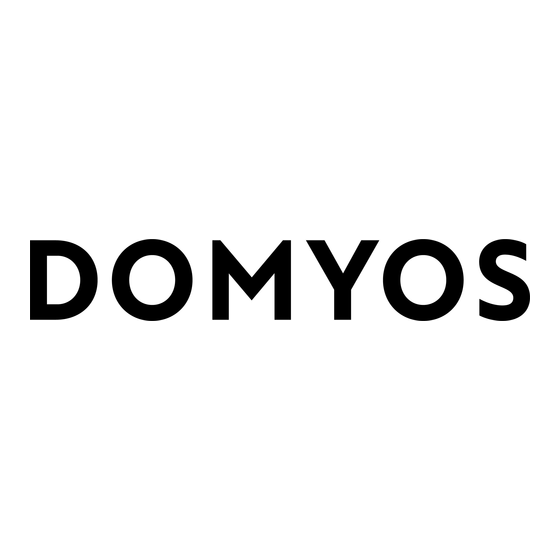Domyos VE 180 사용 설명서 - 페이지 15
{카테고리_이름} Domyos VE 180에 대한 사용 설명서을 온라인으로 검색하거나 PDF를 다운로드하세요. Domyos VE 180 16 페이지.
Domyos VE 180에 대해서도 마찬가지입니다: 사용 설명서 (16 페이지)

E
N
C A R D I O - T R A I N I N G
Cardio training is aerobic exercise (muscle development using oxygen); it enables you to improve your cardiovascular capacity.
The heart pumps this oxygen throughout the entire body, and especially to the muscles that are doing the work.
Taking your pulse regularly while exercising is essential for controlling
your training.
If you don't have an electronic measuring instrument, this is how you do
it :
To take your pulse, place 2 fingers over :
your neck, beneath the ear, or inside the wrist next to the thumb
Don't press too hard :
A – Warm-up phase: progressive effort
The warm-up is the preparatory phase for exercise and gets your body
COMPLETELY READY to start working out.
It is a way to PREVENT INJURIES TO TENDONS AND MUSCLES.
It involves two stages:
WAKING UP THE MUSCULAR SYSTEM, AND OVERALL WARM-UP.
1) You wake up your muscles with a SERIES OF SPECIFIC STRETCHES that
PREPARE YOU FOR EXERCISE: every muscle group is used, and the joints
are stimulated.
2) The overall warm-up makes it possible to put the cardio-vascular and
respiratory system into action gradually, for a better blood supply to
the muscles and better preparation for the exercise. It should be long
enough: 10 minutes for a recreational sport, and 20 minutes for a com-
petitive sport. Note that you should warm up for longer: in the morning
and if you are over 55.
CARDIOVASCULAR TRAINING: EXERCISE ZONE
• Training at 80 to 90% and over of maximum heart rate: Anaerobic and red zones reserved for competitive, specialist
athletes.
• Training at 70 to 80% of maximum heart rate: Endurance training.
• Training at 60 to 70% of maximum heart rate: Getting fit/Burning off fat.
• Training at 50 to 60% of maximum heart rate: Staying in shape/Warm-up.
Beats per minute
Age
If your age differs from those given in the table, you can use the following formulae to calculate your maximum heart rate which corresponds to 100%.
For men: 220 - age
For women: 227 - age
G
More specifically, you improve the tone of your heart muscle and blood vessels.
Cardiovascular training takes oxygen from the air you breathe into your muscles.
C O N T R O L Y O U R P U L S E R A T E
P H A SE S O F P HY S IC A L AC T IV IT Y
Male
L
I
Pressing too hard lessens the blood flow and can slow down the heart
rhythm.
After counting the beats for 30 seconds, multiply by 2 to get the number
of beats per minute.
Example :
A count of 75 beats gives 150 beats/minute
B – Training
The workout is the main phase of your physical activity.
By working out on a REGULAR basis, you can improve your physical fitness.
• Anaerobic work for improving endurance.
• Aerobic work for improving cardio-pulmonary strength.
C – Warming down
This corresponds to low-level activity; it is the gradual "resting" phase. WAR-
MING DOWN returns your cardiovascular, respiratory and circulatory sys-
tems and your muscles to normal functioning (thereby preventing undesirable
side effects such as the build-up of lactic acid, which is one of the major causes
of muscle pain namely, cramps and stiffness).
D - Stretching
You should stretch after warming down. Stretching after exercise: Minimises
MUSCULAR STIFFNESS caused by the build-up of.
Beats per minute
Age
20
S
H
Female
